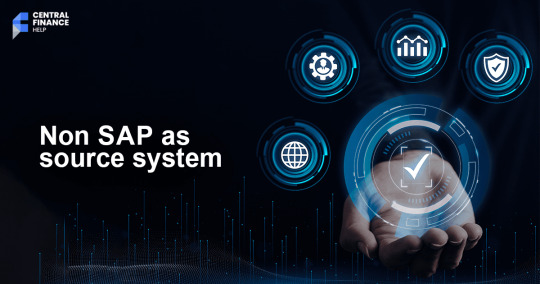#Non SAP As Source System
Explore tagged Tumblr posts
Text

Discover the solution you've been searching for. Learn how to seamlessly integrate a non-SAP source system into your financial operations and get the central finance help you need.
#Non SAP As Source System#SAP Central Finance#SAP S/4HANA#SAP#SAP systems#Central Asset Accounting#Central Reversal & Reposting
1 note
·
View note
Text
Privileging thinness is about sapping our power
The amount of fat and not-so-fat folks who I've seen in comments or who have messaged me saying that fat positive content has made them more confident proves that privileging thinness is about destroying our confidence and sapping our power.
Imagine if we felt as powerful as we actually are. Women's bodies are policed and primarily their weight in order to sap their confidence and destroy their power in all spheres of life (sexual, romantic, scholastic, professional, etc etc).
Men's bodies are policed and while not primarily about weight definitely about fatness as an "unappealing" softness in order to prop up a toxic masculinity where men are chiseled protectors and where social power is generated by might, not right. This is to destroy the power of men who advocate for non-patriarchical moral value systems.
Privileging thinness and framing fatness as disgusting, diseased, and deviant is a not-so-artful social fiction to distract us from our true power by convincing us that our bodies are our source of power. Society and technology has long progressed past the point where our bodies determine who and what we can be. The only people who benefit from keeping us focused on our bodies are those who stand to lose by us realizing our true power.
Reject and revolt against all moral value systems based on bodily characteristics. They are distractions meant to destroy your power.
-ATL
218 notes
·
View notes
Text



Go Go Southern Lesser Galago!
Also known as the South African galago or the mohol bushbaby, the southern lesser galago (Galago moholi) is a small primate from the Galagidae, or bushbaby family. As the name implies, they are located only in southern Africa, from northern South Africa up to Rwanda. Their preferred habitats are savannahs and semi-arid woodlands, where they can often be found high in the canopy, and they are particularly associated with Acacia trees.
The mohol bushbaby is one of the smaller members of its group; at full height they stand no taller than 15 cm (6 in) and weigh only 225 g (7.9 oz). In fact, their tail is longer than their body, easily reaching 23 cm (9 in) in length. While it isn't prehensile, the tail is still an important tool for climbing as it gives G. moholi an excellent sense of balance. Along with their incredible tails, the South African galago also has one of the largest sets of ears of any primate, proportional to its size; these ears can move independently to help the southen lesser bushbaby avoid predators. G. moholi's final distinguishing feature are their eyes, which are incredibly large and a distinctive orange color. Individuals themselves tend to be gray or light brown, which helps them blend in with their surroundings.
South African galagos are almost strictly nocturnal. At night, they forage through the canopy for moths and beetles. These bits of protein, however, are supplemental; the mohol bushbaby's primary source of food is gum, or hardened sap from the Acacia plant. G. moholi has several adaptations allowing it to specialize in gum extraction, including scraping teeth on the lower mandible; long, rough tongues; and digestive systems that have evolved to break down and ferment the tough substance. Because they have very few defense mechanisms, southern lesser galagos are a common prey for many nocturnal species like eagles, owls, snakes, mongooses, civets, and gennets.
One of the few ways the South African bushbaby avoids predation is through its social units. Groups of 2-7-- typically composed of a female, her young, and a few non-reproductive relatives-- forage together. In these groups, their collective night vision and highly-developed hearing allow them to detect and alert each other to predators long before the threat is immanent. While individuals forage seperately, they keep in contact via loud, high pitched calls that can serve as a warning for predators, a point of contact between mother and offspring, or a territorial warning between males.
Male G. moholi live seperately from social groups, and are highly aggressive against other males invading their territory. This area often overlaps that of several female-led groups, but they only come in contact with each other during the mating season. Unusually, the species has two mating seasons through the year; from January to Februrary (late summer) and from October to November (early spring). Following a gestation period of 120 days, females produce a single set of twins each mating season. Each set is weaned after approximately 3 months, and young become fully mature at 300 days. Female offspring may join the mother's group, while males leave to establish their own territory. In the wild, an individual may live up to 16 years.
Conservation status: The IUCN has classified the South African bushbaby as Least Concern. Studies have indicated that the population is stable and, in some areas, increasing. However, in other areas the species is threatened by habitat loss and possibly capture for the pet and bushmeat trade.
If you like what I do, consider leaving a tip or buying me a ko-fi!
Photos
Gerald Doyle
Peter Webb via iNaturalist
#Southern lesser galago#south african bushbaby#Primates#Galagidae#galagos#bushbabies#mammals#savannah mammals#tropical forest mammals#africa#south africa#animal facts#biology#zoology
167 notes
·
View notes
Text


Winterhold Arch-Mage's quarters in the 2nd Era w/ ESO Housing (Happy Anniversary ESO!)
In honor of ESO's 10th anniversary today, I'm gonna share an example of something I did with maybe(?) my favorite game feature, the ESO Housing system.
I'm working on a fic (not yet published) that involves the Arch-Mage's quarters and the College of Winterhold in both the 4th and 2nd Eras. Inspired by writer's block, I decided to recreate the Arch-Mage's quarters in ESO. (We have not yet seen the College of Winterhold in ESO canon.)
Note to writers: some of the details I knew going in, but I actually got some new key details of the story out of this effort. If you're feeling stuck, it can't hurt to try switching up your medium :)


Due to the limitations of ESO's housing system and the boringness of Skyrim's decor, it's more of an homage than a direct 1:1, but I hope it feels loyal in spirit :) More pics (and unnecessary detail) under the cut!
(Sorry I forgot to turn off the Skyrim HUD.)
The addition of fireplaces, built-in bookshelves, a kitchen, and general fanciness are because of the absolute criminal underdecoration of the Arch-Mage's quarters in base Skyrim. (Which actually fits in my fic, but.)


Like, come on Skyrim, not even a fire in the cavernous bedroom of this enormous stone refrigerator on the edge of a freezing ocean?
Most of the architectural discrepancies, such as the 8-sided room vs. Skyrim's 12-sided room, are because of my choice of venue or because of the furnishing selection in ESO.


The saddest of those is the loss of all the cool arches and the dope vaulted ceilings. The most annoying of them (imo) is the non-matching stone. Otherwise Forbidden Stronghold lent itself so well to this task that i chose it over options that would have let me keep the ceilings.
But actually, most of the more glaring discrepancies are directly related to the lore of my fic :)


The alchemy garden is newly-planted in the 2nd Era portion of my fic! The fact that none of those plants are actually harvestable plants in either ESO or Skyrim is just due to ESO's selection of furnishings. But a lot of things aren't: the lighting source being a Silvenari Sap-Stone that grows out of a wisteria tree (which, notably, is alive), the little spring, the moon-sugar—all of those are part of the story, and I think there might be additional Important Plants in there before I'm finished. :)
Also, in my fic, the 4th Era Arch-Mage is the Dragonborn of course, but the 2nd Era Arch-Mage is the first Khajiit Arch-Mage of Winterhold. Because of this endeavor, I wrote a whole scene where he talks about his decor choices 😂 Might get left on the editor's floor, but the overall gist is: the more public-facing areas of the space are Nord-core, so as to not rock boats unnecessarily. As soon as you step into the study and living quarters, it's Khajiiti af, so as to rock boats the right amount.


i have no idea whether people will be interested in this, so I'm going to stop there, but there's more, obviously. And if you made it this far, thanks! And happy anniversary ESO! 🥳
#eso#tesblr#skyrim#elder scrolls online#college of winterhold#my screenshots#eso player housing#tes fanfiction#(kinda)#wip: palimpsest
18 notes
·
View notes
Text
Unlocking Business Intelligence with SAP Analytics Cloud
In today’s fast-paced business landscape, timely and intelligent decision-making is essential for survival and growth. Businesses need tools that not only collect data but also help interpret it in a way that drives actionable insights. SAP Analytics Cloud (SAC) is one such powerful tool. It brings together business intelligence, planning, and predictive analytics on a single cloud-based platform. By integrating data from multiple sources, SAC empowers organizations to make informed, real-time decisions that support long-term success.
Why SAP Analytics Cloud Matters
SAP Analytics Cloud is not just another analytics tool—it is a comprehensive solution that helps businesses visualize, plan, and act. At its core, SAC offers a unified platform where users can analyze data, forecast future trends, and collaborate across departments. It turns raw data into strategic insight, enabling businesses to respond swiftly to market changes and internal demands.
Key Benefits of SAP Analytics Cloud
Centralized Data Management One of SAC’s standout features is its ability to manage data centrally. This allows businesses to pull data from various systems and consolidate it into a single, trustworthy source. It reduces the chance of data duplication or inconsistency, helping teams stay aligned and making data-driven decisions with confidence. Centralized data access also fosters collaboration, as all departments can rely on the same real-time insights.
Interactive Dashboards and Reporting SAC offers customizable dashboards and advanced reporting features that are easy to use—even for non-technical users. The built-in tools, such as SAC Stories and Analytics Designer, help users create visually appealing reports that can be shared easily across teams. Whether it's financial data or supply chain performance, SAC turns complex datasets into actionable visuals that support better decision-making.
Predictive Analytics and Machine Learning With built-in predictive analytics, SAC goes beyond standard reporting. It uses artificial intelligence and machine learning to detect trends, forecast outcomes, and identify anomalies. Businesses can test different scenarios, evaluate the potential impact of decisions, and act with foresight. This ability to anticipate challenges or opportunities is a major competitive advantage.
End-to-End Business Planning SAC combines various aspects of business planning—financial, operational, and strategic—into a single platform. Users can simulate scenarios, assign roles with secure access, and version control their plans. This simplifies planning cycles and ensures that all stakeholders work from a single, accurate set of data. The result is smarter forecasting and more agile business strategies.
User-Friendly and Mobile-Ready SAC’s intuitive interface ensures that even users without a technical background can navigate it with ease. It’s also mobile-compatible, meaning decision-makers can access dashboards and reports anytime, anywhere. This flexibility ensures continuous access to insights, allowing leaders to act quickly when opportunities or issues arise.
Real-World Use Cases of SAC
SAP Analytics Cloud isn’t just theoretical—it has practical applications across industries. Businesses use SAC for:
Self-Service BI: Empowering staff to generate reports independently without IT help.
Planning & Forecasting: Streamlining financial and operational planning with accurate forecasting tools.
SAP Ecosystem Integration: Seamlessly integrating with SAP S/4HANA and SAP Datasphere to enhance analytics.
Operational Optimization: Gaining insights from real-time data to improve business processes and performance.
Why Your Business Should Adopt SAP Analytics Cloud
In an increasingly data-driven world, the ability to analyze and act on information is a must-have. SAC offers competitive advantages through its analytics depth, scalability, and ease of use. It is designed to grow with your business, helping you stay agile and informed as your needs evolve.
Organizations that adopt SAC benefit from lower costs, improved decision-making, and increased agility. Whether you're a small business or a large enterprise, SAC offers the flexibility and intelligence needed to navigate today’s challenges and seize tomorrow’s opportunities.
Conclusion
SAP Analytics Cloud is a strategic asset for any organization aiming to transform data into decisions. From centralized data management to real-time predictive insights, SAC is designed to help businesses thrive. Its user-friendly interface, seamless SAP integration, and powerful planning tools make it a smart choice for companies serious about growth. If you’re ready to take your business intelligence to the next level, SAP Analytics Cloud is worth exploring.
Get in touch with us today to unlock the full potential of SAP Analytics Cloud for your business.
0 notes
Text
Why Smart Small Businesses Are Pairing CRM with ERP—and How It’s Done Right

In today’s fast-evolving digital economy, small businesses face increasing pressure to compete with larger enterprises while maintaining lean operations. That’s where the synergy between Cloud CRM Solutions and Enterprise Resource Planning (ERP) comes into play. By integrating these two powerful systems, small businesses can unlock new levels of efficiency, customer insight, and scalable growth. Learn more at AeyeCRM.
The Power Combo: CRM and ERP for SMBs
Historically, Customer Relationship Management (CRM) and ERP systems have operated in silos. CRM focuses on managing customer data, sales, and service interactions. ERP, on the other hand, handles backend operations like inventory, accounting, and human resources. Today, smart small businesses are breaking down those barriers, merging the two to create a seamless flow of information across the organization.
Why Integration Matters
Centralized Data: Unifying CRM and ERP allows all departments to access real-time data from a single source of truth.
Improved Customer Experience: With customer interaction data from CRM and order fulfillment data from ERP, businesses can deliver personalized, informed service.
Operational Efficiency: Automation between front-end and back-end tasks reduces manual entry and errors.
Faster Decision-Making: Real-time reporting from integrated systems enables quicker and smarter decisions.
How Small Businesses Are Making It Happen
Step 1: Choosing the Right CRM and ERP Platforms
Many small businesses start by selecting a cloud-based CRM such as Salesforce, HubSpot, or Zoho. These platforms offer flexibility, scalability, and robust third-party integrations. For ERP, popular options include Oracle NetSuite, Microsoft Dynamics, and SAP Business One—all of which offer cloud deployment options suitable for SMBs.
Step 2: Planning for Seamless Integration
Partnering with experienced Salesforce consulting or cloud solutions firms, like AeyeCRM, ensures a smooth CRM implementation for SMBs. These experts assess your current tech stack, recommend optimal tools, and map out a step-by-step integration strategy.
Step 3: Automating Key Processes
Automation is where the real ROI begins. Integrated systems can automatically update inventory levels when a sale is made or notify finance teams when a quote is approved—reducing delays and manual work.
Step 4: Training and Adoption
Technology only works if your team uses it. Small businesses that invest in onboarding and training sessions see significantly better ROI. A well-integrated CRM-ERP setup can be intuitive and accessible, even for non-technical staff.
Real-World Example: From Startup to Scalable
A startup in Texas offering eco-friendly office supplies recently partnered with AeyeCRM to implement Salesforce as their CRM and integrate it with Oracle NetSuite. The result? A 40% reduction in order processing time and a 25% increase in repeat customer retention within just six months. By leveraging Cloud ERP integration, they turned their fragmented systems into a unified engine for growth.
Benefits Beyond the Basics
Enhanced Forecasting: Integrated systems use historical data and predictive analytics to improve demand forecasting and resource planning.
Regulatory Compliance: With built-in compliance features in ERP systems and audit trails in CRM, businesses are better prepared for audits and data regulations.
Mobility and Accessibility: Cloud-based platforms allow access to business data from anywhere—perfect for remote teams or traveling sales reps.
Common Challenges and How to Avoid Them
Data Silos: Ensure you’re integrating all relevant modules, not just sales and finance.
Poor Planning: Work with experts who understand both CRM implementation and ERP architecture.
Lack of Training: Allocate time and budget for staff training to maximize system adoption.
Frequently Asked Questions (FAQs)
What is the difference between CRM and ERP?
CRM focuses on managing customer relationships and front-end processes like sales and support. ERP handles back-end functions like inventory, finance, and HR.
Can small businesses afford CRM-ERP integration?
Yes. With cloud-based tools and modular pricing, integration is more accessible and cost-effective than ever before.
How long does integration typically take?
Depending on the complexity, full CRM-ERP integration can take anywhere from 4 to 12 weeks.
What platforms does AeyeCRM support?
AeyeCRM supports Salesforce, Zoho, and HubSpot on the CRM side, and integrates with cloud ERP platforms like Oracle NetSuite, SAP, and Microsoft Dynamics.
Do I need technical expertise to manage the systems after integration?
Not necessarily. AeyeCRM provides ongoing support and training to ensure smooth operation even for non-technical users.
Conclusion
Pairing CRM with ERP is no longer a luxury for small businesses—it’s a competitive necessity. With the right strategy and expert support, SMBs can create a fully connected business system that empowers growth, improves efficiency, and enhances the customer experience. Visit AeyeCRM to get started.
Contact us today to explore tailored CRM and cloud integration solutions.
0 notes
Text
SAP BTP: Driving Digital Transformation
SAP Business Technology Platform (SAP BTP) is a cloud-based, integrated solution that accelerates enterprise digital transformation. By combining data management, analytics, artificial intelligence (AI), application development, automation, and integration, SAP BTP enables businesses to harness data, optimize operations, and innovate across SAP and non-SAP systems. Serving over 27,000 customers and 2,800 partners as of October 2024, SAP BTP is a cornerstone for building intelligent, sustainable enterprises.
SAP BTP Core Pillars
SAP BTP is built on four key pillars:
Database and Data Management: Powered by SAP HANA, tools like SAP Data Intelligence and SAP Master Data Governance enable real-time data processing and governance, creating a unified data landscape for actionable insights from diverse sources.
Analytics and Business Intelligence: SAP Analytics Cloud delivers real-time insights, predictive analytics, and intuitive dashboards, empowering data-driven decisions and strategic planning across business functions.
Application Development and Integration: SAP BTP supports custom app creation with low-code/no-code tools like SAP Build and pro-code options in Java, Python, and ABAP. The SAP Integration Suite connects SAP and third-party systems, streamlining workflows with prebuilt integrations.
Intelligent Technologies: Leveraging AI, machine learning, IoT, and robotic process automation (RPA), SAP BTP automates complex processes. Joule Studio enables secure, scalable AI agents tailored to specific business needs.
SAP BTP Key Benefits
SAP BTP simplifies data migration, automates processes, and accelerates decision-making, offering up to a 514% ROI over three years. It reduces silos by integrating SAP and non-SAP systems, enhancing business agility. Companies like Mahindra have automated over 250 processes, while Harrods and CONA Services improved system connectivity and onboarding efficiency using SAP Integration Suite. The City of Hamburg utilized SAP BTP’s generative AI to streamline document handling, demonstrating its ability to deliver scalable, intelligent solutions.
SAP BTP Real-World Impact
SAP BTP’s flexibility supports diverse industries. Volkswagen México optimized data processes with SAP Analytics Cloud, while Pif Paf Alimentos built agile mobile apps using SAP Build’s low-code tools. Its multi-cloud architecture, compatible with Azure, AWS, Google Cloud, and Alibaba Cloud, ensures scalability and compliance, making it adaptable to enterprise needs.
Conclusion
SAP BTP transforms data into business value, enabling innovation, automation, and integration. By combining advanced analytics, AI, and low-code development, it empowers organizations to build intelligent applications, optimize processes, and achieve sustainable growth in a dynamic digital landscape. SAP BTP is the foundation for enterprises aiming to stay competitive and future-ready.
0 notes
Text
CentralFinanceHelp.com has information on using non-SAP systems as the source system for SAP Central Finance. Recognize the advantages of this strategy and the integration process
2 notes
·
View notes
Text
InsightGen AI Services by Appit: Unlock Real-Time Business Intelligence
Redefining Data-Driven Decision Making in the AI Era
In today’s hyperconnected and competitive environment, businesses can no longer rely on static reports or delayed analytics. The need for real-time insights, predictive intelligence, and data democratization is more critical than ever. Enter InsightGen AI Services by Appit—a cutting-edge solution designed to empower organizations with instant, actionable business intelligence powered by artificial intelligence and machine learning.
With InsightGen, Appit is revolutionizing how businesses understand data, forecast outcomes, and make mission-critical decisions—in real time.
What Is InsightGen AI?
InsightGen AI is a next-gen platform developed by Appit that enables businesses to extract deeper, smarter, and faster insights from structured and unstructured data. Unlike traditional BI tools, InsightGen combines AI-driven analytics, real-time data processing, and intuitive visualization dashboards to give decision-makers an always-on, intelligent pulse of their organization.
🧠 Core Capabilities:
Real-time analytics and dashboards
Predictive modeling and forecasting
Natural language query interface (NLQ)
AI-powered anomaly detection
Automated data storytelling and alerts
Integration with ERPs, CRMs, data lakes & cloud platforms
Why InsightGen Matters in 2025 and Beyond
⏱️ Real-Time Decision Making
In a world where trends shift by the minute, InsightGen enables organizations to act on data as it happens, not after it’s too late.
🔮 Predict the Future with Confidence
With built-in ML models, users can accurately forecast sales, churn, demand, and risk, allowing leadership to prepare for future scenarios with data-backed confidence.
🌐 Unify Data Across Sources
From siloed systems to cloud-native environments, InsightGen ingests data from various sources—SAP, Oracle, Salesforce, AWS, Azure, and more—to present a single source of truth.
💬 Ask Questions in Plain English
With Natural Language Query capabilities, even non-technical users can ask questions like "What was our top-selling product last quarter?" and receive instant visual answers.
🔔 Instant Alerts and Automation
InsightGen detects outliers, anomalies, and trends in real-time and sends automated alerts—preventing costly delays and enabling proactive actions.
Use Cases: Driving Intelligence Across Industries
🛒 Retail & eCommerce
Track inventory and sales in real time
Analyze customer buying behavior and personalize offers
Forecast seasonal demand with AI models
🏭 Manufacturing
Monitor production KPIs in real-time
Predict equipment failure using predictive maintenance AI
Optimize supply chain operations and reduce downtime
💼 Financial Services
Real-time fraud detection and transaction monitoring
Investment performance analytics
Compliance tracking and risk forecasting
🧬 Healthcare
Patient data analysis and treatment outcome prediction
Hospital resource planning and optimization
Monitor patient flow and emergency response trends
🎓 Education
Analyze student performance and dropout risks
Real-time reporting on admissions and operations
Personalized learning analytics for better outcomes
Security, Scalability, and Compliance
Appit designed InsightGen AI with enterprise-grade architecture, offering:
🔐 Role-based access control and end-to-end encryption
☁️ Cloud, on-prem, and hybrid deployment options
📊 Support for GDPR, HIPAA, CCPA, and other data regulations
⚙️ Auto-scaling and high availability infrastructure
InsightGen ensures that your data is safe, compliant, and available—always.
The Technology Behind InsightGen AI
InsightGen is built using a powerful technology stack including:
AI/ML Engines: TensorFlow, PyTorch, Scikit-learn
Data Platforms: Apache Kafka, Snowflake, Google BigQuery, Redshift
Visualization Tools: Custom dashboards, embedded BI, Power BI integration
Integration APIs: RESTful services, JSON, XML, Webhooks
AI Assistants: Integrated chat support for querying reports and insights
Case Study: Fortune 500 Firm Unlocks $12M in Cost Savings
Client: Global logistics and warehousing company Challenge: Disconnected data systems, slow insights, reactive decision-making Solution: Appit deployed InsightGen AI with real-time inventory tracking, predictive maintenance alerts, and automated KPI reporting. Results:
📉 $12M saved in operational inefficiencies
📊 65% faster decision cycles
🔄 90% automation of manual reporting
📈 40% improvement in customer SLA compliance
Getting Started with InsightGen AI Services
Whether you're a mid-sized enterprise or a Fortune 1000 company, InsightGen is scalable to meet your analytics maturity level. Appit offers end-to-end support from:
Data strategy and planning
Deployment and integration
Custom dashboard design
AI model training and tuning
Ongoing analytics support and optimization
Why Choose Appit for AI-Powered Business Intelligence?
✅ Decade-long expertise in enterprise software and AI
✅ Tailored analytics solutions for multiple industries
✅ Fast deployment with low-code/no-code customization options
✅ 24/7 support and continuous model refinement
✅ Trusted by leading organizations worldwide
With InsightGen AI, you’re not just collecting data—you’re unlocking real-time, business-changing intelligence.
The Future Is Now: Make Smarter Decisions with InsightGen
In 2025, businesses that react fast, predict accurately, and personalize effectively will win. InsightGen AI by Appit delivers the intelligence layer your enterprise needs to stay ahead of the curve.
Don’t let your data gather dust. Activate it. Understand it. Act on it.
0 notes
Text
Complete Guide to Corporate Travel Booking: Smarter Choices for Growing Businesses 🚀

Corporate travel booking isn't just about reserving flights and hotels. For Indian businesses today, it's about managing costs, ensuring employee safety, and streamlining every journey. With rising business travel spend—expected to cross ₹4 lakh crore in India by 2026 (source: FICCI)—companies need smarter solutions.
That’s where Tejas Travels, a leading Tour and Travels company in India, steps in to simplify corporate mobility.
👉 But what exactly makes corporate travel booking crucial? Let’s break it down.
What is Corporate Travel Booking & Why Every Business Needs It 💼
Corporate travel booking is the process of organizing work-related trips—covering flights, hotels, ground transport, and travel compliance. Unlike personal bookings, corporate travel demands negotiated rates, reporting, and adherence to company policies.
In India, startups like OYO for Business and global players like Egencia are making waves. But many SMEs still struggle without a formal system. A 2023 GBTA study found that 43% of Indian firms lack an official travel policy, leading to overspending and employee dissatisfaction.
Tejas Travels bridges this gap by offering managed corporate travel solutions, including hotel tie-ups, flight bookings, and bus rental for large groups or last-mile employee transport.
Facing Hurdles? 5 Challenges in Corporate Travel Booking & Smart Fixes 🚧
Every travel manager knows the chaos of last-minute bookings, unclear approvals, or expense leaks. Common challenges include:
⚠️ Ensuring duty of care—keeping travelers safe during disruptions ⚠️ Managing travel risk compliance under standards like ISO 31030 ⚠️ Avoiding hidden costs from unmanaged bookings ⚠️ Tracking expenses for GST input credits ⚠️ Balancing cost-saving with traveler comfort
In 2022, when Mumbai’s monsoon disrupted air travel, Tejas Travels helped clients switch to bus rental services, ensuring executives reached Pune overnight when flights were grounded. Their coach rental fleet added flexibility where air or rail failed.
Why Choosing a Corporate Travel Agency Like Tejas Travels Saves You More 💰
You could let employees book their own trips—or you could rely on a partner who negotiates rates, handles emergencies, and provides reports.
Tejas Travels, known for both corporate travel booking and bus services across India, brings the advantage of:
✅ Pre-negotiated airline and hotel deals ✅ A dedicated account manager ✅ 24x7 helpline for travel disruptions ✅ Integration of bus hire options for off-site events or mass employee transport
A Bengaluru-based IT firm saved 18% on annual travel expenses after switching to a managed travel plan with Tejas Travels.
Self-Booking vs Managed Travel: Which Works Better for Indian Companies? 🤔
Today’s employees love self-booking tools like Skyscanner or Cleartrip. But does it work for business travel?
Managed travel through Tejas Travels gives you control over cost, approvals, and policy compliance. You get a dashboard to track travel spend, travel alerts, and consolidated invoices for GST filing.
In contrast, unmanaged travel can lead to non-compliant bookings, fragmented expenses, and missed savings from corporate negotiated rates.
A 2021 Deloitte study showed companies with managed travel save up to 22% annually compared to unmanaged booking. For Indian SMEs looking to scale, the choice is clear.
Top Tech & Tools Transforming Corporate Travel Booking in India 📱
Corporate travel booking today rides on technology. From SAP Concur to TravelPerk, tools automate approvals, expense capture, and itinerary management.
Tejas Travels integrates such tools with its booking platform, letting clients combine flight, hotel, and bus travel into a single itinerary. Their app allows managers to approve trips remotely and travelers to access e-tickets instantly.
During large events like Auto Expo Delhi, Tejas Travels offers wedding bus hire and corporate shuttle solutions, managing logistics for both VIP and mass transportation needs.
Crafting a Corporate Travel Policy That Works (And Saves Money) ✍️
Without a travel policy, bookings turn chaotic. A policy defines:
📝 What class of travel is allowed 📝 Which hotels or airlines employees can book 📝 Approval workflows for travel requests 📝 Guidelines for sustainable travel and bleisure travel
Tejas Travels helps clients draft policies that balance cost and traveler comfort. Their team also advises on incorporating eco-friendly travel options, aligning with India’s growing focus on sustainability.
In 2024, 34% of Indian businesses reported adding sustainable travel clauses to their policies (source: ET Travel World).
Choosing the Right Corporate Travel Partner: What to Look For 🔍
Not all travel partners are equal. When evaluating a corporate travel agency, check for:
⭐ Proven record in duty of care ⭐ Capability to handle travel risk management under ISO 31030 ⭐ Access to negotiated fares and loyalty program integration ⭐ Flexibility to provide bus transportation for events or large groups ⭐ 24x7 customer support with multilingual teams
Tejas Travels ticks all these boxes, combining over two decades of experience with nationwide coverage in bus rental companies and travel logistics.
FAQs About Corporate Travel Booking with Tejas Travels ❓
“How can we book both flights and buses for a corporate event?” → Tejas Travels offers bundled bookings including travel bus rental for intra-city or inter-city needs.
“Do you provide invoices with GST compliance?” → Yes, Tejas Travels provides GST-ready invoices and detailed expense reports.
“Can we integrate your booking with SAP Concur?” → Absolutely. Tejas Travels supports API integration with major expense management software.
Ready to Simplify Corporate Travel? Partner with Tejas Travels Today 🌟
Managing corporate travel doesn’t have to be complicated. With Tejas Travels, you get end-to-end solutions covering flights, hotels, and even coach rental for large team movements.
👉 Contact Tejas Travels to discuss your company’s travel needs and explore custom corporate packages designed for Indian businesses.
Stop juggling multiple vendors—let Tejas Travels handle your business journeys so you can focus on growing your company.
0 notes
Text

SAP Central Finance Training for Beginners and Professionals
SAP Central Finance Online Training Certification & Course As businesses increasingly implement SAP S/4HANA for digital transformation, SAP Central Finance (cFIN) has become an essential solution for companies looking to standardize financial processes and reporting across intricate, multi-ERP environments. Whether you're a new graduate joining the SAP community or a seasoned SAP consultant looking to reskill, SAP Central Finance training provides a sound route to career growth and hands-on implementation expertise. In this article, we’ll explore the importance of SAP Central Finance, who should learn it, and how structured training can benefit both beginners and professionals. What is SAP Central Finance? SAP Central Finance is a deployment choice within the S/4HANA suite that enables businesses to consolidate financial information from several ERP systems — including SAP ECC and even non-SAP systems — into a single S/4HANA instance. This central system is used as a financial reporting and processing center, making it possible for enterprises to have real-time insights without disturbing their current ERP environments. It delivers: Centralized financial reporting Consolidated financial planning and control Real-time financial data replication A stepping stone for S/4HANA transformation Why Learn SAP Central Finance? Organizations need SAP Central Finance consultants to provide smoother S/4HANA transitions and greater transparency and efficiency in finance operations. Experts with training in Central Finance are perfectly placed for high-value jobs in SAP implementation, system integration, and digital transformation of finance. Below are some reasons to learn SAP Central Finance: Central Finance is a central part of most international S/4HANA projects. It provides cross-system visibility and improves financial reporting. This skill is highly sought after in all industries. It provides wonderful opportunities for SAP FICO, S/4HANA, and technical consultants to diversify. Who Should Enroll? This course is suitable for: SAP FICO consultants interested in extending to S/4HANA Financial professionals interested in stepping into the SAP space System integration experts dealing with SAP landscapes SAP technical consultants who need to understand data replication (SLT) and interfaces (AIF) Beginners who want to start from scratch and gain functional and technical knowledge Training Overview: What You’ll Learn A well-structured SAP Central Finance training program, such as the one offered by Proexcellency, typically includes: Fundamentals of SAP S/4HANA and Central Finance architecture Key components like SLT (System Landscape Transformation), AIF (Application Interface Framework), and MDG (Master Data Governance) Data mapping and source system replication Central Finance object and integration setup configuration Business use cases and real-time scenarios Live SAP system hands-on exercises Implementation best practices and troubleshooting SAP Central Finance interview preparation and certification Training is typically conducted online, providing flexibility to learners all over the globe. It is also designed to support both novice and advanced professionals, with the basics adequately addressed before proceeding with higher-level subjects. Conclusion Whether you are beginning your SAP journey or want to increase your expertise, SAP Central Finance training unlocks high-impact positions in financial transformation and enterprise technology. With proper training from the best like Proexcellency, you can lay a solid foundation, develop hands-on expertise, and propel your SAP career to the next level.
[email protected], +91-9148251978,+91-9008906809
0 notes
Text
Sure! Here's a compelling, human-style blog post about Fiber Supplements, including detailed descriptions of the active substances and their dosages. The content is crafted to inform, engage, and convince customers to buy.
Feel Lighter, Live Brighter: The Power of Fiber Supplements for Your Daily Wellness
Let’s face it—most of us aren’t getting enough fiber. In a fast-paced world filled with processed foods and busy schedules, it’s no wonder digestive discomfort, bloating, and irregularity are so common. That’s where a high-quality fiber supplement comes in. It’s your daily reset button, supporting digestion, promoting gut health, and even helping with weight management.
Fiber supplements are a simple yet powerful way to take control of your wellness. They’re not just for people with digestive issues—they’re for anyone who wants to feel energized, balanced, and in tune with their body. Let’s explore the top active substances in fiber supplements and why they’re essential to your daily routine.
1. Psyllium Husk – The Gut Soother
Psyllium husk is a soluble fiber derived from the seeds of Plantago ovata. It acts like a sponge in your gut—absorbing water and forming a gel-like substance that helps soften stool and promote regular bowel movements. It’s particularly effective for relieving constipation, supporting heart health by lowering cholesterol, and improving blood sugar control.
Recommended dosage: Start with 5 grams once per day, and gradually increase to 10 grams daily, split between morning and evening. Mix with plenty of water to ensure smooth digestion.
2. Inulin – The Prebiotic Fiber
Inulin is a natural fiber found in chicory root, bananas, and asparagus. It’s a prebiotic, which means it feeds the beneficial bacteria in your gut, supporting a healthy microbiome. A balanced gut flora improves digestion, reduces inflammation, and can even enhance mood and immunity.
Recommended dosage: Begin with 2–3 grams per day, and slowly increase to 5–10 grams as your body adapts. Too much too soon can cause bloating, so ease in gradually for best results.
3. Acacia Fiber – The Gentle Digestive Aid
Acacia fiber, sourced from the sap of the Acacia Senegal tree, is another prebiotic powerhouse. It’s a soluble fiber known for being particularly gentle on the digestive system, making it perfect for sensitive stomachs. It helps regulate bowel movements and supports satiety, helping you stay full longer.
Recommended dosage: Take 5 grams once or twice daily, mixed into water or smoothies. It blends easily without thickening, making it a convenient and non-bloating option.
4. Methylcellulose – The Non-Fermenting Fiber
Methylcellulose is a synthetic but safe form of soluble fiber that does not ferment in the gut, making it ideal for those who want to avoid gas and bloating. It helps bulk up stool and supports overall regularity. This is often the go-to option for those with IBS or food sensitivities.
Recommended dosage: 2 capsules (or ~1–2 grams) taken up to 3 times daily with at least 8 oz. of water. Be consistent to maintain its digestive benefits.
5. Glucomannan – The Appetite Controller
Glucomannan is a natural fiber from the root of the konjac plant. It’s highly absorbent and expands in the stomach, promoting a feeling of fullness and reducing appetite. It also helps control blood sugar and cholesterol levels, making it an excellent choice for overall metabolic support.
Recommended dosage: 1 gram (1000 mg) taken 3 times daily, 30 minutes before meals with a full glass of water. It’s an effective tool for healthy weight management and digestion.
Why Fiber Supplements Work for Everyone
No matter your diet or lifestyle, fiber is essential. From improving digestion and balancing blood sugar to reducing cravings and promoting a healthy gut, the benefits are massive. Yet most people only get 15 grams of fiber a day—far short of the recommended 25–30 grams. That’s why fiber supplements are more than just convenient—they’re necessary.
And the best part? You can mix and match. Many supplements combine multiple fiber types to support both soluble and insoluble needs, offering a complete solution in just one scoop or capsule.
Ready to Feel the Difference?
If you’re tired of feeling sluggish, bloated, or irregular, it’s time to get your digestion back on track. Our premium fiber supplements feature clinically supported doses of psyllium husk, inulin, acacia, methylcellulose, and glucomannan—all designed to work gently and effectively.
✨ Support your gut. Curb your cravings. Energize your life.
Shop now and take the first step toward better digestion and total wellness.
Would you like me to recommend specific product combinations or create a comparison chart for different fiber types?
"Stay ahead of the curve with our website's expert insights and industry updates."
0 notes
Text
Solar Panel Cleaning Robot Technology Explained
In the pursuit of cleaner energy and higher efficiency, solar panel maintenance has taken a giant leap forward—thanks to automation. As solar installations grow in size and complexity, so does the need for reliable, efficient, and safe cleaning methods. Enter the solar panel cleaning robot, a high-tech solution revolutionizing the way solar systems are maintained across residential, commercial, and utility-scale installations.
Whether you're a homeowner in the sunny Central Valley or a facility manager overseeing acres of panels, understanding robotic cleaning technology can help you boost your system's output while saving time, water, and money.
Why Clean Solar Panels at All?
Before diving into the technology itself, it’s worth revisiting why cleaning your panels matters. Solar panels are designed to absorb sunlight, but when dust, dirt, pollen, bird droppings, or other debris coat their surfaces, their ability to generate power is reduced.
Numerous studies and field reports have shown that dirty panels can lose 15% to 30% of their potential energy output. In arid and agricultural regions—where dust and particulates are high—this loss can be even greater.
And while rain may help rinse off some debris, it's rarely enough—especially when sticky substances like sap or bird droppings are involved. That's where automated systems like the solar panel cleaning robot come in.
What Is a Solar Panel Cleaning Robot?
A solar panel cleaning robot is an autonomous or semi-autonomous device designed to traverse the surface of solar panels and clean them using mechanical brushes, microfiber rollers, air jets, or water-fed systems. Some are compact enough for residential rooftops, while others span meters across and are built for industrial installations.
There are two main types:
Water-based Robots – These use deionized water and gentle brushes to remove dirt without leaving mineral streaks.
Dry Brush Robots – Designed for arid zones where water conservation is a priority, these use rotating brushes or air jets to remove dust and particulates without liquid.
Core Features of Modern Solar Panel Cleaning Robots
Modern robots are engineered to meet a wide range of performance and environmental challenges. Here are some of the most important features:
1. Lightweight and Non-Abrasive
Robots must be gentle on the panels they clean. They’re typically constructed from lightweight materials like carbon fiber or aluminum and use non-abrasive brushes to avoid scratching the glass or damaging anti-reflective coatings.
2. Autonomous Navigation
Most commercial robots use sensors, rails, or AI-assisted mapping to navigate solar panel arrays autonomously. They detect panel edges, adjust for panel tilt, and even avoid obstacles.
3. Programmable Operation
Through IoT technology, many robots can be scheduled remotely, activated based on weather data, or deployed using smartphone apps. Some can also report performance metrics and cleaning completion stats in real-time.
4. Adaptable Power Supply
Robots are often powered by batteries, solar panels, or plug-in systems. Some even recharge themselves using the very energy the panels produce, creating a closed-loop cleaning system.
How Solar Panel Cleaning Robots Work Step by Step
Here's a breakdown of a typical cleaning cycle for a solar panel cleaning robot:
Deployment – The robot is either manually placed or automatically moved to the start of the panel row.
Pathfinding – Using onboard sensors or rails, it determines the panel layout.
Cleaning Initiation – Brushes, rollers, or jets begin to operate. Water is either pumped from an external source or stored in an onboard tank (for larger robots).
Traversal – The robot moves across each panel, often in a zigzag or serpentine path, ensuring full surface contact.
Completion and Return – Once finished, it returns to its docking station, either for charging or the next scheduled job.
Applications of Solar Panel Cleaning Robots
Residential Systems
Smaller rooftop robots are now available for home users who want to avoid ladders or potentially damaging DIY cleaning methods. These units are compact, user-friendly, and increasingly affordable.
Commercial Installations
Factories, office buildings, and schools with large-scale panel installations benefit greatly from automated cleaning. Robots reduce labor costs, improve safety, and can be scheduled during non-operational hours.
Utility-Scale Solar Farms
Robots are becoming essential at solar farms spanning hundreds of acres. Manual cleaning would take weeks, but fleets of coordinated robots can clean thousands of panels per day.
Benefits of Robotic Solar Cleaning
1. Efficiency Gains
Clean panels = more power. Robotic cleaning ensures a consistent level of cleanliness across an entire installation, eliminating “missed spots” and inconsistent results from manual crews.
2. Water Conservation
Especially in drought-prone areas, solar panel cleaning robots that use dry brushes or minimal deionized water provide critical environmental benefits. Some systems report using 90% less water than traditional hose-down methods.
3. Labor Savings
Once installed, robotic systems reduce or eliminate the need for human labor, which translates to lower long-term maintenance costs.
4. Safety
Roof access and scaffolding are risky. Robots handle the job while you stay safely on the ground.
5. Longevity
Regular cleaning extends the life of your solar panels by preventing corrosive buildup and reducing the risk of hotspots or cell degradation.
Integrating Bird Deterrent Systems
While cleaning panels addresses dirt and dust, another challenge often goes unaddressed—birds. Pigeons and other birds like to nest under and around solar arrays, leaving behind corrosive droppings and even pecking at wiring.
Some modern solar panel cleaning robot systems integrate bird deterrent features to tackle both issues simultaneously. These may include:
Ultrasonic emitters that produce sounds birds dislike
Motion sensors that trigger light or vibration responses
Physical barriers that robots install or maintain during cleaning
Combined, these measures prevent new bird settlements and ensure your panels stay cleaner longer between automated cleanings.
Challenges and Limitations of Cleaning Robots
No technology is perfect, and solar panel cleaning robots have their limitations:
High Initial Investment: Especially for commercial-grade robots.
Compatibility Issues: Not all panel layouts or mounting angles are robot-friendly.
Maintenance Required: Robots themselves require occasional upkeep.
Weather Dependency: High winds or rain may delay scheduled cleaning cycles.
Despite these drawbacks, advances in design and falling production costs are making robotic solutions more accessible than ever.
Choosing the Right Cleaning Robot
When selecting a solar panel cleaning robot, consider the following:
1. Panel Configuration
Is your system flat, angled, or curved? Are panels closely spaced or separated?
2. Accessibility
Is your system on the ground, on a rooftop, or on a multi-story structure?
3. Water Access
Can you easily supply deionized water, or would a dry-clean system be better?
4. Frequency of Cleaning
Are you in an area with heavy dust or bird activity? That will affect the specs you need.
5. Bird Risk
If birds are a known problem, choose a system that supports add-on bird deterrent devices or integrated repellents.

Future of Solar Panel Cleaning Robots
As solar adoption rises worldwide, the demand for efficient maintenance grows. In the coming years, we can expect:
AI-Driven Robots that learn panel layouts and optimize their paths
Self-Cleaning Panels supported by nanocoatings and robot-compatible materials
Drone-Assisted Cleaning for inspecting and directing cleaning robots remotely
Subscription-Based Robot Services for residential users who prefer to lease rather than buy
This evolution will make solar power even more attractive and affordable for everyday users.
Integrating Solar Panel Cleaning Robots with Smart Energy Systems
As smart home and smart grid technologies evolve, solar panel cleaning robots are becoming integral components of larger, interconnected systems. In smart energy homes, where solar energy generation is paired with battery storage and intelligent consumption, panel cleanliness directly affects energy forecasting, load balancing, and overall efficiency.
By linking cleaning robots to home automation hubs or energy monitoring platforms, users can:
Receive cleaning alerts based on efficiency dips
Schedule automated cleanings before peak production periods
Integrate with weather apps to avoid cleaning during storms or dusty conditions
Optimize cleaning frequency to balance performance gains and operational costs
Some premium robotic systems even allow remote monitoring via smartphone apps, offering real-time views, diagnostics, and usage stats. For facility managers at commercial or utility-scale solar farms, this enables fleet-wide oversight and predictive maintenance.
Predictive Maintenance Powered by AI
Advanced solar panel cleaning robots are now leveraging AI to support predictive maintenance—not just of the robot itself but of the entire solar system.
Here’s how:
AI sensors can detect anomalies in panel performance across cleaning cycles, identifying potential microcracks or cell failures.
Pattern recognition can help differentiate between common contaminants (like bird droppings versus ash) and recommend targeted cleaning cycles.
Usage data collected over time can help forecast future needs, reduce water use, and adjust scheduling based on actual panel soiling patterns.
By combining robotic cleaning with AI and cloud analytics, solar panel owners are getting closer to “set-it-and-forget-it” solar—where systems self-maintain, self-monitor, and self-optimize.
Solar Panel Cleaning Robots and the Global Water Crisis
Water conservation is no longer just a local issue. In regions suffering from severe drought—California, India, the Middle East—minimizing water usage is essential. Traditional panel cleaning can use up to 5 gallons per panel per cleaning. Multiply that across 10,000 panels, and the impact becomes clear.
Enter the water-saving robot.
Dry-brush and microfiber roller technologies now allow robotic dry cleaning systems to achieve similar cleanliness to water-fed methods—without the waste. This is especially critical in large solar farms located in desert or agricultural zones, where dust is high, and water is precious.
Moreover, some eco-conscious cleaning systems incorporate water reclamation and recycling technology, capturing runoff and filtering it for reuse in the next cycle.
When combined with bird deterrent strategies that reduce fouling, the need for frequent water-based cleanings is further reduced. This makes robotic systems a strong ally in sustainable solar farming.
Case Study: Agricultural Installation in California’s Central Valley
A major vineyard in Fresno County recently adopted a solar panel cleaning robot system across its 500kW solar array. The farm had been experiencing:
18–22% seasonal drop in output due to dust and pollen
Bird nesting under arrays, leading to fouling and corrosion
High labor costs and safety risks during cleaning operations
Solution: A modular robotic system was deployed, paired with a bird deterrent netting and ultrasonic repeller setup.
Outcomes over one year:
Cleaning efficiency improved panel output by 19% annually
Bird nesting dropped to near zero
Water use for cleaning dropped by 85%
Labor hours spent on maintenance dropped by 60%
The robots were scheduled twice monthly during the dry season and monthly in winter. The system paid for itself in just under 18 months through energy production gains and operational savings.
The Role of Bird Deterrent Technology in Solar Maintenance
Birds are more than just an occasional annoyance—they can pose a serious threat to solar panel performance and integrity. Nesting materials can block airflows, overheat modules, or even spark electrical issues. Bird droppings are acidic and can corrode panel frames and coatings.
Modern solar panel cleaning robot setups often incorporate bird deterrent components, such as:
Ultrasonic repellers that emit frequencies unpleasant to birds
Motion-activated sprinklers or light flashers
Perimeter mesh or spikes to block nesting access
Laser deterrent systems that project harmless movement patterns to keep birds away
Integrating deterrents with robotic cleaning routines ensures that birds are dissuaded from returning—even as old droppings and nesting signs are systematically cleaned away. It’s a preventive + corrective combo that leads to cleaner panels and lower maintenance cycles.
Comparison: Manual Cleaning vs. Robotic Cleaning
FeatureManual CleaningRobotic CleaningLabor CostHighLow (after setup)Water UseModerate to HighLow to NoneSafetyRisky on rooftopsSafe and automatedConsistencyVariableUniform and programmableSpeedSlow on large installationsFast, especially in scaleAvailabilityRequires schedulingOn-demand or presetBird Deterrent IntegrationRareOften built-in or compatibleMaintenance ReportingManual notesAutomated, with diagnostics
Robotic systems clearly offer long-term advantages, particularly for those managing multiple arrays, remote installations, or seeking higher ROI from solar investments.
Environmental Impact and Carbon Footprint Reduction
One of the most compelling reasons to adopt solar panel cleaning robots is their positive environmental impact. Beyond saving water, these systems:
Reduce the need for diesel-powered cleaning equipment
Minimize human travel for on-site maintenance (especially in remote farms)
Prevent chemical use for cleaning agents (thanks to dry or water-only systems)
Improve panel output, reducing reliance on backup fossil energy sources
And when paired with bird deterrent systems that limit droppings and corrosive buildup, the frequency and intensity of cleaning cycles drop—further enhancing sustainability.
Training and Installation Requirements
While residential plug-and-play robots are increasingly user-friendly, commercial and industrial robotic systems still require professional installation and training. Key steps include:
Site assessment: Evaluating panel layout, tilt, access, and soiling factors
Rail system setup (if needed): For robots that require guided tracks
Integration with energy management software
Training personnel on operations, diagnostics, and maintenance
Some vendors offer maintenance plans or leasing options, lowering the barrier to entry and allowing clients to test systems without long-term commitment.
Public Policy and Industry Incentives
Governmental agencies are increasingly offering incentives not just for solar adoption—but for maintaining solar performance. In states like California, where energy production affects net metering credits and tax incentives, poor panel maintenance can cost money.
Emerging legislation may soon:
Offer rebates for installing water-saving cleaning robots
Mandate minimum cleaning and inspection standards for large solar sites
Provide insurance discounts for automated maintenance systems
Include bird deterrent measures in environmental compliance requirements
By staying ahead of these policies, solar owners can maximize their long-term returns while remaining compliant and environmentally responsible.
Tips for Getting Started with a Solar Panel Cleaning Robot
Thinking of upgrading to an automated cleaning system? Here's how to get started:
Audit your current system: Assess your panel array's size, location, and cleaning needs.
Evaluate your ROI potential: Calculate how much energy (and money) you're losing to soiling.
Compare robot types: Look at dry vs. wet, autonomous vs. rail-guided, and feature sets.
Check for bird risk: If pigeons or crows are an issue, prioritize models with bird deterrent compatibility.
Contact a certified installer: Many solar contractors now offer robot add-ons or packages.
What’s Next in Solar Panel Cleaning Robot Development?
Looking ahead, R&D is pushing the boundaries of solar cleaning robotics in exciting ways:
Swarm Robotics: Multiple small robots collaborating across arrays, like robotic ants
Solar + Wind Panel Cleaning Bots: Combo systems for hybrid renewable installations
Nano-Coating Integration: Robots that apply self-cleaning or anti-reflective coatings during operation
Voice-Control and AI Learning: Fully interactive systems that learn user preferences and adjust on-the-fly
As the technology matures, expect solar panel cleaning robots to become as essential as inverters and battery packs in every solar setup.
Final Thoughts
The solar revolution isn’t just about panels—it’s about maintaining those panels for decades of clean, efficient energy. With the advent of advanced solar panel cleaning robots, system owners have a powerful tool to combat dust, dirt, and even avian interference.
Whether you're managing a rooftop in Fresno or a solar field in the Mojave, a robot may be your best line of defense against performance loss—and your strongest ally in building a sustainable, high-yield solar future.
Add in bird deterrent systems, smart scheduling, and predictive analytics, and you're not just cleaning solar panels—you're upgrading to a next-gen solar strategy.
0 notes
Text
How to Test Salesforce the Easy Way (Without the Headaches)
If you've ever tried to test Salesforce manually, you know it can feel like wrestling with a cloud-shaped octopus. Custom objects, workflows, Apex triggers… It’s like Salesforce is daring you to break it.
But here’s the good news: You don’t have to go it alone.
Provar, the Salesforce automation testing tool built for Salesforce (and obsessed with stability), is here to make testing way easier—and, dare we say, even kind of fun. 🙌
Whether you're QA, DevOps, or just someone tired of clicking through regression tests manually, we’ve got your back. Let’s break down what it really takes to test Salesforce effectively—and how Provar [insert] fits right into your stack.
🤔 Why Testing Salesforce Is So Tricky
Salesforce is powerful, no doubt. But that power comes with complexity. Here are a few of the pain points folks like you run into:
⚠️ Common Salesforce Testing Challenges
Dynamic DOM structure: IDs and fields can change every time a page loads.
Custom code everywhere: Apex, Visualforce, Lightning components—you name it.
Data dependencies: Tests fail if your test data isn’t just right.
Slow feedback loops: Manual testing = slow releases = frustrated teams.
And, of course, every company has its own custom Salesforce setup. That means no two test strategies are the same.
But don’t panic. Let’s walk through how to solve this step by step—with Provar guiding the way.
✅ What It Really Means to Test Salesforce
Before you dive in with tools and scripts, let’s clarify what testing Salesforce should actually cover:
When you're gearing up to test Salesforce, it’s important to cover all the key areas—not just UI clicks. Here’s a quick breakdown of the main types of testing and why they matter:
Unit testing is where you test small chunks of Apex code to make sure your custom logic behaves the way it should. Think of it as testing individual building blocks before assembling the whole system.
UI testing focuses on simulating what a real user would do—clicking buttons, filling forms, and navigating through the interface. It’s essential to confirm that everything works the way your users expect it to.
Regression testing ensures that previously working features haven’t accidentally broken after new changes. It’s your safety net that keeps releases smooth and bug-free.
Integration testing checks how Salesforce connects with external systems like SAP, Slack, or DocuSign. You want your tools to talk to each other without hiccups, and this type of testing keeps those connections strong.
Performance testing looks at how fast and stable everything runs. Nobody likes a slow CRM, so testing for speed and reliability helps avoid frustrating lag.
Now, imagine trying to do all that by hand. Yeah,… not ideal.
🚀 How Provar Simplifies Salesforce Testing
This is where Provar comes in and changes the game.
🔧 Built For Salesforce, Not Just With It
Provar isn’t just another Selenium wrapper. It’s natively integrated with Salesforce. That means it:
Understand your metadata and custom objects
Works with standard and Lightning components
Handles dynamic fields without breaking
No more messing with XPath or chasing dynamic IDs. You test what matters—Provar handles the grunt work.
🧪 Easy Test Creation (Even for Non-Coders)
Got team members who aren’t super technical? No problem.
Provar lets you create tests using:
A drag-and-drop interface
Reusable test cases
Natural language-like steps (you can literally say “Click on Login”)
Suddenly, your whole team can contribute to QA—not just your automation engineers.
🔄 Built-in Support for CI/CD
Using tools like Jenkins, GitHub Actions, or Azure DevOps? Provar slides right into your pipeline, automating test runs and reporting so you never release broken code.
“Provar fits into our CI/CD pipelines like a glove. We run thousands of tests with every commit and catch issues instantly.” — Real user feedback from [insert review source]
📊 Clear Reporting That Even Executives Can Understand
Let’s be real: stakeholders don’t want to look at logs. They want clean dashboards.
Provar provides:
Test run summaries
Pass/fail trends
Click-throughs to failed steps
Now everyone’s in the loop, from devs to directors.
🧠 Pro Tips: Best Practices to Test Salesforce Like a Pro
Want to take your testing to the next level? Here are a few quick wins:
🔁 Automate Regression Testing First
These tests give the biggest bang for your buck and prevent old bugs from coming back.
🧼 Keep Your Test Data Clean
Use Provar’s built-in test data management to reset data between test runs. Clean data = reliable results.
🛠️ Shift Testing Left
Involve QA early in the development process. Provar makes this easy since it’s built for collaboration.
🌍 Test Across Profiles and Roles
Salesforce behaves differently for different users. Make sure your tests cover admin, sales, service, and partner profiles.
📚 Real-World Use Case: Provar in Action
Let’s say you’ve got a Salesforce org that supports:
Lead creation from a web form
Auto-assignment via flows
Email notifications
Integration with Marketo
A full end-to-end test with Provar might look like this:
1. Open lead form
2. Fill in the required fields
3. Submit the form
4. Verify lead appears in Salesforce
5. Check assignment owner
6. Confirm the email was sent
7. Validate lead status in Marketo
Set it up once in Provar, run it whenever, and get instant feedback.
🧩 Can Provar Work With My Stack?
Absolutely. Provar plays nicely with:
Salesforce Classic & Lightning
Custom-built components
APIs (REST/SOAP)
CI/CD pipelines
TestRail, Jira, and other QA tools
You can even run tests in the cloud or on your machines.
✨ Wrapping Up: Test Salesforce the Smart Way
Salesforce is amazing, but testing it doesn’t have to be frustrating. With Provar, you can finally:
Cut down on manual test time
Prevent bugs before they go live
Get faster feedback during development
Keep your org stable and scalable.
So the next time someone asks how your team tests Salesforce, you’ll have a simple answer:
“We use Provar.”
0 notes
Text
How to Integrate SAP Analytics Cloud (SAC) into Your Business Strategy
In a data-driven world, making smarter decisions faster is no longer optional—it's essential. SAP Analytics Cloud (SAC) is the intelligent platform that unifies business intelligence (BI), planning, and predictive analytics to empower organizations with real-time insights, automated processes, and AI-enhanced forecasting.
By integrating SAC into your business strategy, you gain the tools to turn raw data into actionable intelligence, helping your business adapt, innovate, and thrive in today’s ever-evolving market landscape.
Why SAP Analytics Cloud Matters
With SAP Analytics Cloud, your organization can move beyond traditional reporting and unlock a deeper understanding of performance, customers, operations, and market trends. Built-in AI and machine learning algorithms identify patterns, generate insights, and reduce the burden of manual data prep—freeing your teams to focus on strategic goals.
Whether it’s streamlining workflows, improving customer journeys, or enhancing financial planning, SAC acts as your central hub for insight-led transformation.
Top Benefits of Integrating SAP Analytics Cloud into Your Business Strategy
1. Enhance Customer Experience with Intelligent Insights
Use SAC to understand customer behavior and preferences through detailed analytics. Deliver more personalized experiences and build stronger customer relationships that increase loyalty and lifetime value.
2. Streamline Operations with Real-Time Analytics
SAC’s AI-powered automation simplifies complex workflows, speeds up data processing, and eliminates manual errors—making your operations leaner, faster, and smarter.
3. Improve Forecasting with Smart Predict
Leverage SAC’s Smart Predict feature to anticipate future trends with unmatched accuracy. It automatically selects the best predictive models and provides insights into key drivers behind potential outcomes.
4. Drive Higher Revenue through Strategic Decisions
Access consolidated, reliable data to make informed decisions that maximize profitability and growth. SAC ensures your business strategy is always rooted in real-time performance metrics and future projections.
5. Optimize Production Planning
For manufacturing and supply chain businesses, SAC provides deep visibility into operations, helping to fine-tune resource allocation, production scheduling, and logistics planning for optimal efficiency.
A Seamless Fit Into Your Business Model
SAC integrates easily with SAP and non-SAP systems, connecting data sources across departments. Build custom dashboards, collaborate across teams, and centralize insights—all from a single platform that grows with your business needs.
1 note
·
View note
Text
SAP Manufacturing ERP Software Solutions at Maivin
In the fast-paced and competitive manufacturing industry, staying ahead requires more than just high-quality products. It demands streamlined processes, real-time data access, and powerful planning tools. That’s where SAP Manufacturing ERP Software comes into play—and at Maivin, we specialize in empowering small and medium-sized manufacturing businesses with this transformative technology.
What is SAP Manufacturing ERP Software?
SAP Manufacturing ERP Software is an end-to-end enterprise resource planning solution designed specifically for the needs of the manufacturing industry. It seamlessly integrates every aspect of your operations—from production planning and inventory management to quality control and supply chain optimization.
Whether you're managing complex shop floor operations or coordinating with suppliers, SAP ERP for the manufacturing industry provides the visibility, automation, and control you need to run efficiently and scale confidently.

Why Maivin?
At Maivin, we’re more than just a CRM software company—we’re your dedicated technology partner. Our team is deeply experienced in implementing SAP solutions tailored to small and medium-sized businesses. We understand the unique challenges faced by manufacturers and deliver personalized ERP solutions that streamline operations, reduce costs, and enhance productivity.
Key Features of SAP Manufacturing ERP Software
1. End-to-End Production Planning
Our SAP-based production planning software helps you manage and monitor your entire production lifecycle. From scheduling work orders to optimizing machine usage, the software ensures that you meet deadlines without overextending your resources.
Plan and forecast demand accurately
Align production schedules with real-time inventory
Minimize downtime with automated alerts
2. Inventory and Warehouse Management
Inventory control is the backbone of efficient manufacturing. SAP ERP software includes advanced inventory management tools to help you track materials, manage stock levels, and reduce waste.
Real-time stock visibility
Barcode and RFID support
Automatic stock replenishment alerts
3. Shop Floor Management
With integrated shop floor management, you gain full visibility and control over your production lines. Monitor performance, identify bottlenecks, and ensure compliance with operational standards.
Real-time machine data tracking
Performance analytics for operators and equipment
Paperless work instructions and checklists
4. Quality Control and Compliance
SAP ERP ensures that your products meet the highest standards by integrating quality checks at every production stage. Define custom criteria, log inspections, and generate compliance reports with ease.
Real-time defect tracking
Non-conformance management
Automated quality documentation
5. Supply Chain and Procurement
SAP’s supply chain visibility capabilities help you source smarter and collaborate with suppliers more effectively. Gain full insight into material flow, delivery timelines, and vendor performance.
Streamlined procurement processes
Vendor rating and evaluation tools
Integrated supplier portals
6. Real-Time Analytics and Reporting
Make informed decisions with powerful real-time analytics. SAP ERP collects data across departments and visualizes key performance indicators (KPIs) to give you actionable insights.
Custom dashboards and reports
Predictive analytics using historical data
Integration with BI tools for deeper insights
Benefits of Using SAP Manufacturing ERP Software at Maivin
✅ Tailored for SMBs
Unlike generic ERP systems, our SAP solutions are customized to fit the budget and scope of small and mid-sized manufacturers.
✅ Rapid Implementation
With our proven deployment methods, we ensure fast and seamless implementation—so you can start seeing ROI quickly.
✅ Industry Expertise
Our consultants have deep knowledge of manufacturing workflows and compliance requirements, ensuring that your ERP solution aligns with real-world needs.
✅ Ongoing Support
We don’t disappear after deployment. Maivin offers ongoing training, support, and system updates to keep your operations running smoothly.

Industries We Serve
Maivin provides SAP Manufacturing ERP Software for a wide range of sectors, including:
Automotive Component Manufacturing
Industrial Equipment
Electronics and Electrical Manufacturing
Food and Beverage Production
Textile and Garment Manufacturing
Chemical and Pharma Industries
No matter your specialization, our ERP experts will customize SAP to match your operational goals.
Future-Ready ERP for a Digital Manufacturing Era
The manufacturing industry is undergoing a digital transformation. Technologies like IoT, AI, and machine learning are revolutionizing how factories operate. With SAP Manufacturing ERP Software, your business is ready to adopt Industry 4.0 innovations:
Integrate IoT sensors for machine-level data
Automate maintenance schedules based on real-time usage
Leverage AI-driven forecasting for smarter production planning
By choosing Maivin’s SAP ERP, you're not just investing in software—you're future-proofing your business.
Why Now is the Right Time to Invest
Delaying digital transformation can cost your business in efficiency, customer satisfaction, and profitability. Whether you're facing challenges with manual processes, inaccurate data, or lack of integration, it’s time to consider a smarter solution.
SAP ERP software for manufacturing gives you the tools to:
Reduce operational costs by up to 20%
Improve on-time delivery rates
Boost production efficiency and throughput
Enhance visibility across all departments
Ready to Take the Next Step?
If you’re a small or medium-sized manufacturing company looking to scale, SAP Manufacturing ERP Software from Maivin is the solution you’ve been waiting for. Our expert team will guide you from consultation to go-live—and beyond.
Let us help you unlock your full potential with smart, scalable, and integrated ERP software designed for the manufacturing world.
Contact Maivin today to schedule a free demo or consultation. Together, let’s build the future of your business.
0 notes